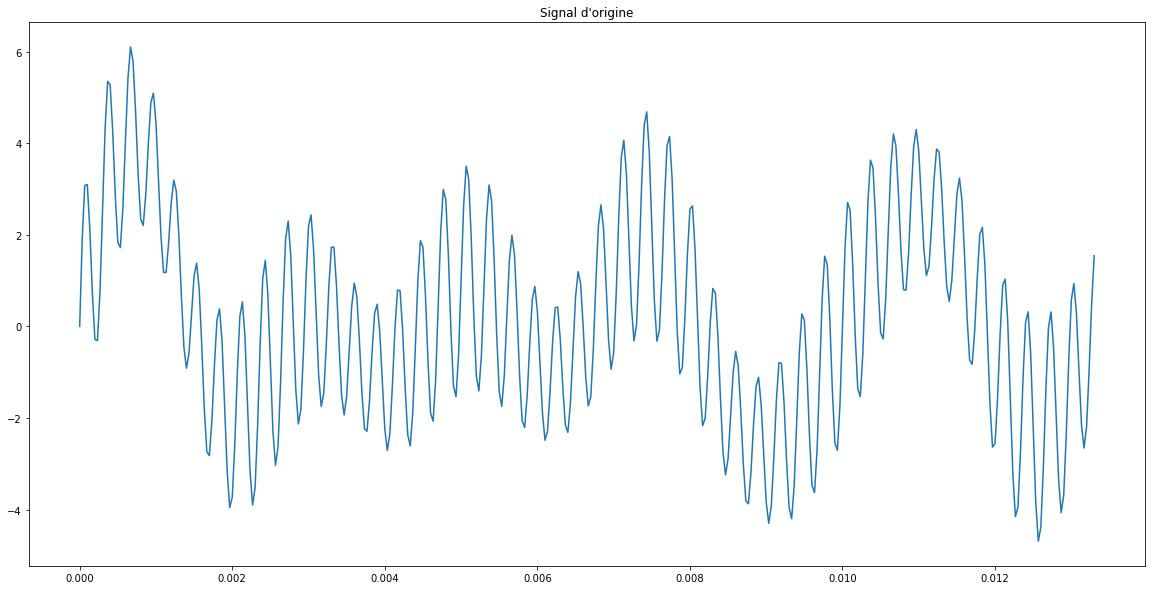Fourier transform
The Fourier transform is an invertible operation applied to certain functions. It is an important tool for the study of functions and signals.
Intuition through polynomials
Let's start the explanation by studying a simpler and more intuitive case, which will help us later to understand what exactly this Fourier transform does.
Consider any polynomial of order
This polynomial decomposes quite naturally into a sum of monomials. These monomials form a base of polynomials. Each polynomial can thus be represented by its coordinates in this base of monomials.
This result, although rather simple, is already extremely powerful. If all polynomials can be determined only by their coefficients (i.e. their coordinates in the canonical basis of monomials of smaller degrees in the broad sense), then we can linearly reverse the problem and determine the coefficients of a given polynomial.
From a set of observations and measurement results, we can then find the best polynomial approximation of the relationship between observations and results. 1
For simplicity, we can use the following notation:
To solve this system we can go through the standard decompositions (LU, QR and SVD) and determine the most satisfactory solutions (e.g. in the least squares sense or limiting the noise).
Without going into details here, for this kind of approximations it can be interesting to choose another vector basis for the set of polynomials. The problem with the canonical basis is that it is not orthonormal: this can lead to some complications in numerical computations making the results unusable 2.
For example, we can replace the matrix introduced above by the matrix composed of the evaluations for each observation of the first Legendre polynomials.
All this to go where?
We have seen here that determining a vector basis for polynomials of any given order allows us to study them well, to approximate them, and to represent them in a more practical way especially in numerical computation.
Now we will extend this process to the study of any real functions.
Basis of functions
In this part we work with functions from
Scalar product for two complex functions
To have a notion of orthogonality, we need to define a scalar product in the prehilbert space of complex functions:
Note that:
Also, [to be completed]
For practical reasons, we prefer the vector basis formed by complex exponentials.
This one exists simply by the fact that:
Recalling Euler's formula:
We now have an orthogonal basis of the complex plane, let us take a vector of this basis:
We can notice that it is also a unit vector:
So we have an orthonormal basis.
Fourier series
Fourier series allow to express
Definition of the Fourier transform
How to extend this to non-periodic functions?
For this, we can see the non-periodic functions as periodic functions but of "infinite period". The Fourier transform is then defined for any function
The Fourier transform of a function is unique and allows to describe it completely, provided that it exists. It is another representation of the function.
To use the terminology used in the description of Fourier series, this transform is in some way a function of the coordinates of the function
The Dirac delta function
So far the idea of the Fourier transform can be understood as an extension by continuity of Fourier series. This generalizes things well since it is now possible to express a function in the vector space mentioned above by a linear combination of a set of non-continuous vectors.
What about the discrete combinations of the base vectors? How to express them?
For this purpose we introduce a rather special function: the dirac delta function.
The dirac delta function is a zero real function for any non-zero real, and whose value is indeterminate (it depends on the conventions used) in zero. It is a "peak".
Now let us notice quite naturally that:
(Note: the
Important note: the function
Now, if a function
With
Let us now calculate its Fourier transform:
Resource on the dirac delta function: chapter1 (ubc.ca)
For more comments on this particular function: Dirac delta function.
Inverting the transform
Quite naturally, from the expression of the Fourier transform of a function we can find the original function:
Frequency interpretation
We can visualize this as frequencies
Very natural in the study of sound
Data compression
But what is the Fourier Transform? A visual introduction. - YouTube
Purrier Series (Meow) and Making Images Speak – Bilim Ne Güzel Lan (bilimneguzellan.net)
Few examples
Example 1
Let a signal
This result is coherent: the given signal comes from a composition of two complex exponentials, so its transform is simply composed of two peaks that identify the parameters of the two complex exponentials. These peaks occur when
Indeed, we do have:
Example 2
Let's imagine a signal like this.

This could be an audio recording for instance.
Taking its Fourier transform will allow us to determine the harmonics of this signal.

In a practical case, it might be useful to suppress high or low frequencies.
Here is what it looks like for this signal:


Notes
We have dealt here only with the case of continuous functions / signals. The Fourier transform also exists in the case of functions with discrete pre-images.
The normalization of the Fourier transform is not systematic. Thus, depending on the field of application or the conventions, we will prefer to define it with or without normalization. The factor
The ideas mentioned here can also be used in the field of image compression:
- Vandermonde matrix - Wikipedia↩
- A poor conditioning can lead to unusable results. The discretization of the values used throughout the calculation is the main cause.↩
- Lp space — Wikipédia↩
Suggestions are enabled for this page. Feel free to make comments on the different paragraphs.